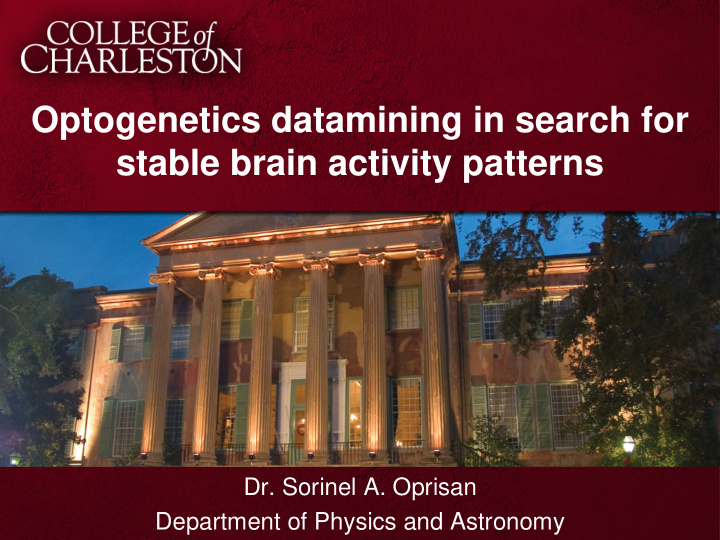



Optogenetics datamining in search for stable brain activity patterns Dr. Sorinel A. Oprisan Department of Physics and Astronomy
ILLUMINATING THE BRAIN, NATURE | Vol 465 | 6 May 2010
Contents 1.What is Optogentics? 2.Applications of Optogentics 3.Experimental Setup 4.Data Analysis 5.Conclusions 6.Acknowledgments
1. What is Optogentics? 2005, Karl Deisseroth and his then-postdoc Ed Boyden inserted a light- sensitive channel from green algae, called channelrhodopsin-2 (ChR2), into neurons growing in a dish. ILLUMINATING THE BRAIN, NATURE | Vol 465 | 6 May 2010
1. What is Optogentics? Genetically engineered viruses carry light-triggered proteins into the brain of the animal; the viruses can be tailored to attach themselves to specific groups of cells. ILLUMINATING THE BRAIN, NATURE | Vol 465 | 6 May 2010
1. What is Optogentics? The brain cells can then be activated by focused light; only those cells that are infected will respond to the light delivered into the brain by fiber optic strand. ILLUMINATING THE BRAIN, NATURE | Vol 465 | 6 May 2010
2. Applications of Optogentics • Treatments for brain diseases like Alzheimer's, Parkinson's and epilepsy. Tailored optogenetic viruses could specifically work on the appropriate cells, rather than using chemicals that flood the entire brain. • Restore lost motor function : "optical cuff" (tiny LEDs emitted blue light) ensures that all constituent nerve fibers would receive adequate stimulation from brief impulses of light. Optical stimulation reproduced the proper firing order of muscle fibers, inducing contractions similar to those that take place under normal conditions. (Nature Medicine 16, 1161–1165 (2010)). http://www.technovelgy.com/ct/Science-Fiction-News.asp?NewsNum=2369
2. Applications of Optogentics • Enhancing/disrupt learning and memory: stimulate Hcrt neurons using a laser diode directed to the lateral hypothalamus (10 s of light pulses, 20 Hz, 20 mW, 477 nm). – Stimuli disrupt sleep and induce arousal. – Memory consolidation occurs during sleep. – Results: Fragmenting sleep after the learning phase of the novel object recognition task significantly decreased the performance of mice on the subsequent day. Memory was unaffected if the average duration of sleep episodes was maintained at 62–73% of normal. (Optogenetic disruption of sleep continuity impairs memory consolidation, PNAS, 2010)
3. Experimental setup Male PV-Cre mice (B6; 129P2 - Pval btm1(Cre)Arbr/J Jackson Laboratory (Bar Harbor, ME, USA) were infected with the viral vector (AAV2/5. EF1a. DIO. hChR2(H134R) - EYFP. WPRE. hGH, Penn Vector Core, University of Pennsylvania) delivered to the mPFC as described in detail in Dilgen et al. (2013). Electrophysiological data were recorded using an optrode positioned with a Narishige (Japan) hydraulic microdrive. Extracellular signals were amplified by a Grass amplifier (Grass Technologies, West Warwick, RI, USA), digitized at 10 kHz by a 1401plus data acquisition system, visualized using Spike2 software (Cambridge Electronic Design, LTD., Cambridge, UK) and stored on a PC for offline analysis.
3. Experimental setup Line noise was eliminated by using a HumBug 50/60 Hz Noise Eliminator (Quest Scientific Inc., Canada). The signal was band- pass filtered online between 0.1 and 10 kHz for single- or multi- unit activity, or between 0.1 and 130 Hz for local field potentials (LFP) recordings. Light stimulation was generated by a 473 nm laser (DPSS Laser System, OEM Laser Systems Inc, East Lansing, MI, USA), controlled via a 1401plus digitizer and Spike2 software (Cambridge Electronic Design LTD., Cambridge, UK). Light pulses were delivered via the 50 $\mu$m diameter optical fiber glued to the recording electrode (Thorlabs, Inc, Newton, NJ, USA).
4. Data analysis Surrogate data. (a) An ensemble of 100 surrogate data sets similar to the original time series, but consistent with the null hypothesis, were generated using Tisean. (b) The discriminating statistic for the original trials and for each of their surrogates over all five groups
4. Data analysis Phase resetting of FLPs. (a) The free-running neural oscillator was perturbed at different phases and, as a result, its phase was reset due to a transient change in the length of the current cycle during which the perturbation was active (b) The average membrane potential of 100 noisy traces. (c) LFP recordings also aligned at laser stimulus onset show an average LFP trace (black thick trace) that is almost noise free and retains some spectral characteristics of its components.
4. Data analysis
4. Data analysis
4. Data analysis Time lag estimation. The first zero crossing of autocorrelation function is around 1500 Delta t (a) and the first minimum of the average mutual information is around 2000 Delta t (b) with Delta t = 10 -4 s.
4. Data analysis Percentage of false nearest neighbors. (a) The percentage of false nearest neighbors changes with the ratio f (distances between neighbor points in different embedding dimensions) (b) Eliminate temporal correlation between too closely spaced points in a time series with variable Theiler window. (c) The percentage of FNN is also a good discriminating statistics.
4. Data analysis
4. Data analysis
4. Data analysis ``8''-shaped attractor and its topologically equivalents. The same data sets were reconstructed in three dimensions with different delay times to produce topologically equivalent attractors. (a) A typical ``8'' shaped attractor made of two twisted loops can be obtained for a delay time of 1900 Delta t. Using a delay time 2200 Delta t, the attractor is ``untangled'' and becomes quite flat (b).
5. Conclusions • We showed that the recorded LFPs from mPFC of ChR2 expressing PV+ interneurons could be successfully embedded in a three dimensional space. • We found the same ``8''-shaped attractor, or its topologically equivalent counterparts after appropriate phase shifting, in all six animals, which covers over 80% of recorded data. All the other attractors were produced by low-amplitude and higher frequency oscillations of LFPs, which led to a more complex structure of the attractor.
Acknowledgments This research was supported by • Summer HHMI Fellowship to Patrick Lynn, and • NSF-CAREER Award IOS-1054914 to Dr. Sorinel A. Oprisan We are grateful to our MUSC collaborators Dr. Antonieta Lavin Dr. Tamas Tompa Patrick Lynn Julia Imperatore Jessica Helms
Recommend
More recommend